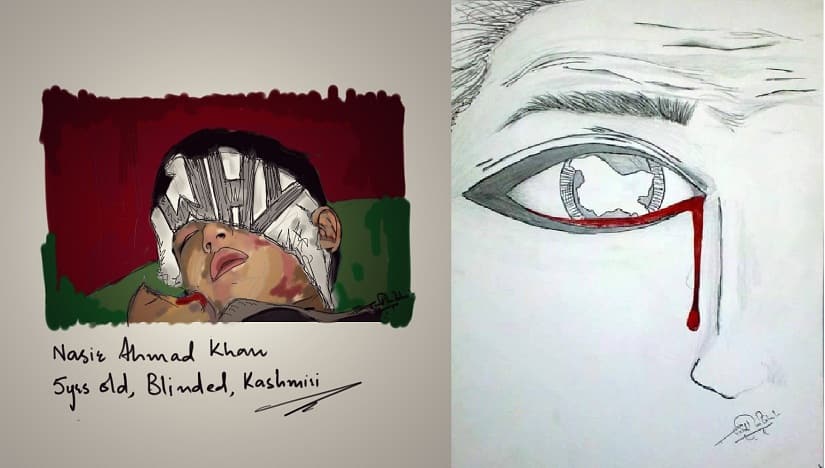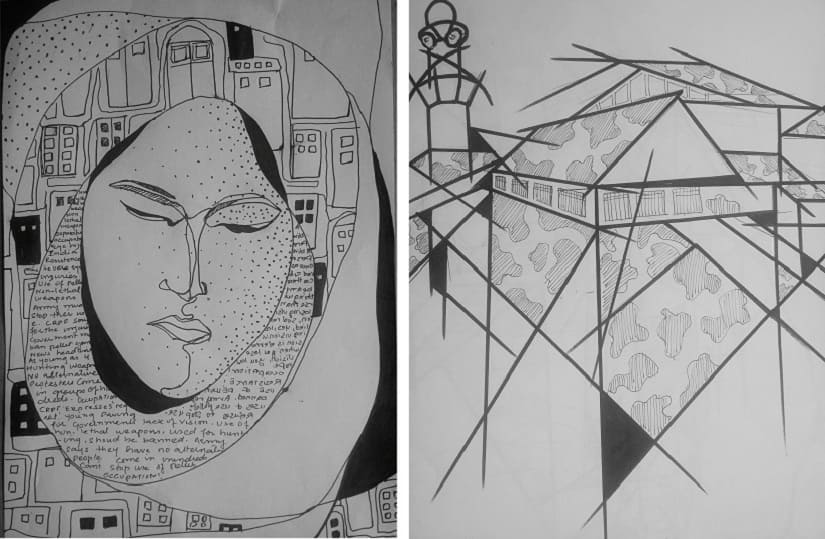Twenty-three-year old artist Khytul Abyad was angry to see what was happening in Kashmir but trying to draw something while being trapped at her home in South Kashmir’s Anantnag district amid strict curfew since the on going uprising started on 8 July after the killing of popular militant commander Burhan Muzaffar Wani, 22, in an encounter in Kokernag area of South Kashmir. In the ongoing uprising, 51 civilians have been killed, more than 3,500 injured, including the government forces, and at least 500 received metal pellet injuries, including loss of eyesight. It is the 18th day of curfew and shutdown in the Valley, and a medical emergency was to be declared due to the number of injured persons being brought to the hospitals. Mostly these were the youth who came on to the streets to endorse the path Wani had taken — fighting against the state by picking up gun. [caption id=“attachment_2923190” align=“alignnone” width=“825”]  A cartoon by Mir Suhail[/caption] Just before this uprising in Kashmir, young artists, including Abyad, had turned a fallen Chinaar into an artwork in Kashmir University. But barely a few weeks after that women, men and children fell to the government forces’ bullets, pellets and tear-gas shells, fired to quell the mass protests. Trapped in their homes, many artists have been trying to reflect upon the situation that is set to change the course of Kashmir’s politics in near future. In Kashmir, where red colour in a painting signifies blood, even an artist’s canvas is perforated with pellets and bullets. “I always wondered, why don’t girls go out for stone throwing, we too get angry,” says Abyad. “Art is the only medium I had. Though I found it hard to get into the process, to initiate it, but I did. When so much is going on around you, you’re not sure which part to focus on.” For the first three days of the uprising, Abyad kept making sketches but she wasn’t even able to draw properly. Somehow it worked and she started to draw. “Although it wasn’t very relatable, I was happy that I am working on something that’s bothering me. I made some drawings that were inspired from the uprising. I’m working on a story that shows how I see the Kashmir issue,” she said. One of the sketches Abyad drew was after pellets hit a 25-year-old, Shameema, and another is of Insha, 14, who was hit by pellets and lost her eyesight permanently. Many others show the town of Anantnag and other scenes of the uprising. She made those after continuously reading about the victims of pellets in the news. [caption id=“attachment_2923192” align=“alignnone” width=“825”]  Art by Syed Mujtaba Rizvi[/caption] Many such stories have been told in last two weeks. But it was an image of a five-year-old Nasir Ahmad, with bandaged left eye lying on a hospital bed in Srinagar that shook people. On seeing this image, artist Syed Mujtaba Rizvi was unable to react to it immediately but later he made a digital artwork based on the photograph taken by Habib Naqash. “It reminded me of Aylan Kurdi who became the symbol of refugee crisis and human suffering not long ago,” says Rizvi. According to Nasir’s family, the paramilitary forces had poked a sharp object into his eye and beaten him up. “I wanted to respond to the situation through my art practice but even that was not fully possible since I did not have access to my art materials or the Internet," says Rizvi. “Also it was very difficult to react immediately because the situation is so painful. I barely escaped injury/death while trying to shop for essentials one evening.” During the 2010 mass uprising in which more than 120 civilians were shot dead by the forces, Rizvi had made a sketch that he felt was more relevant today, especially because of so many people who lost their eyesight. The current uprising has also made him change the focus of his work in progress — a series called “Revolution: Still in labour pain”. “I had started to move my attention to people outside Kashmir,” he said, “but I think I need to devote my energy towards the 50 mothers who lost their sons and daughters this year.” [caption id=“attachment_2924486” align=“alignnone” width=“825”]  Artworks by Khytul Abyad[/caption] While Rizvi’s project is in progress, cartoonist Mir Suhail draws daily cartoons at the Rising Kashmir newspaper. After the suspension of Internet and phones, Suhail used a cousin’s broadband to send his cartoons to his editor. He describes one of his popular cartoons on the uprising as: “In Kashmir, you can’t kill dogs, cows, or animals and there was so much debate on not eating beef but you can kill humans here. So, I made a cartoon based on how a hunting season has begun in Kashmir to kill civilians. I am an oppressed Kashmiri who is being killed and caged and it becomes a base due to which I make cartoons.” Kashmir’s uprising is not coming up only on canvas or paper; it has also seeped into music. Paramilitary forces beat up rising singer and composer Ali Saffudin during the 2008 Amarnath Land Row and he came home with a limp. He wrote a song about it that gave a vent to his anger. Two weeks ago, Ali was in South Kashmir when he heard Wani had been killed and saw people’s anger on the streets. He decided to write a song but as the cycle of killings continued, he turned into a volunteer at a hospital, not touching his guitar. “You no longer are an artist,” he says. “At that time your suffering as an oppressed subject takes its toll on you. The fact that I’m a Kashmiri living under occupation was pinching me. After watching how the Indian media reported (the issue) I decided to pick up my guitar, write a song, and in my way, support this uprising.” For over a week, he worked on a song in which he has used the verses of famous Kashmiri poet Abdul Ahad Azad called Inqalab o Inqalab, merged with Bob Marley’s ‘Get Up Stand Up’ and Junoon’s ‘Meri Aawaz Suno’. “With this song I wanted to show the Kashmiri sensibility of resistance, which the Indian media is completely neglecting,” he adds. “If your house is burning, you can never write a song about it. If fire services doesn’t come and lets you burn on your own, you’ve to tell the world what the fire services did to you. And if I can tell that through a song, I should do it.” Listen to the song here: Fahad Shah is an independent journalist, who frequently writes for Foreign Affairs, The Diplomat, The Christian Science Monitor, Scroll.in, and Hindustan Times. He is the editor of the anthology Of Occupation and Resistance: Writings from Kashmir (2013) and also founding editor of The Kashmir Walla magazine. He can be followed at @pzfahad.
The canvases of Kashmiri artists are perforated with pellets and bullets
Advertisement
End of Article


)
)
)
)
)
)
)
)
)



